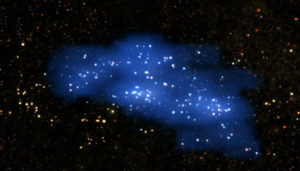In astronomy news this week: A gargantuan supercluster of galaxies lurks in the early universe, while data from the Fermi telescope hint at two supermassive black holes locked in a gravitational dance.
A Colossal Galaxy Supercluster in the Early Universe

L. Calçada(ESO) / O. Cucciati et al. 2018
The most massive structures in the universe are superclusters, complex webs of galaxies spanning hundreds of millions of light-years. Now, researchers have identified what may be a gargantuan predecessor to modern superclusters. The discovery could help astronomers better understand how these behemoths arose and evolved into the cosmic beasts around us today.
The light from this proto-supercluster takes about 11 billion years to reach Earth, so astronomers see it as it was roughly 2.8 billion years after the Big Bang. The discoverers nicknamed it Hyperion, after one of the Titans from Greek mythology. Seven galaxy clusters, ranging in mass from 10 trillion to 270 trillion Suns, appear linked together by filaments of galaxies across roughly 20 million billion billion cubic light-years of space. The entire ensemble is about as massive as 4.6 quadrillion suns.
While this isn’t the first galaxy cluster seen in the early universe, none are as massive or as sprawling as this one.
Olga Cucciati (National Institute for Astrophysics, Bologna, Italy) and colleagues discovered the adolescent supercluster in data from the VIMOS (Visible Multi-Object Spectrograph) Ultra Deep Survey, a project to obtain redshifts of roughly 10,000 faint galaxies using the Very Large Telescope in Chile.
The team’s results will appear in Astronomy & Astrophysics and can be found on the astronomy preprint arXiv.
Wobbly Gamma Rays from a Far-Flung Galaxy
A pair of supermassive black holes whipping around one another could explain recurring fluctuations in gamma rays coming from the heart of a remote galaxy.
In 2015, researchers working with NASA’s Fermi Gamma-ray Space Telescope detected hints of a periodic modulation of gamma rays emitted by a galaxy designated PG 1553+113, which sits nearly 5 billion light-years away. Now, by analyzing 10 years of Fermi data, astronomers confirm that something is causing the intensity of those gamma rays to waver every 2.2 years. What’s more, the gamma-ray vacillation matches similar changes seen in visible light, X rays, and radio waves.
Stefano Ciprini (Italian Space Agency, Rome) and colleagues announced their finding at an October 17th press conference.
All this radiation is likely being generated by blazing gas swirling around a pair of supermassive black holes, the researchers argue. As the black holes orbit each other, fountains of gamma rays precess, alternately pointing towards us and then leaning away. The researchers do caution, however, that this interpretation is just one possibility. However, if a pair of supermassive black holes does live in this galaxy, it could be a good target for the European Space Agency’s eLISA satellite, a gravitational-wave detector scheduled to launch in 2034.

S. Ciprini et al. 2018
 0
0
Comments
You must be logged in to post a comment.